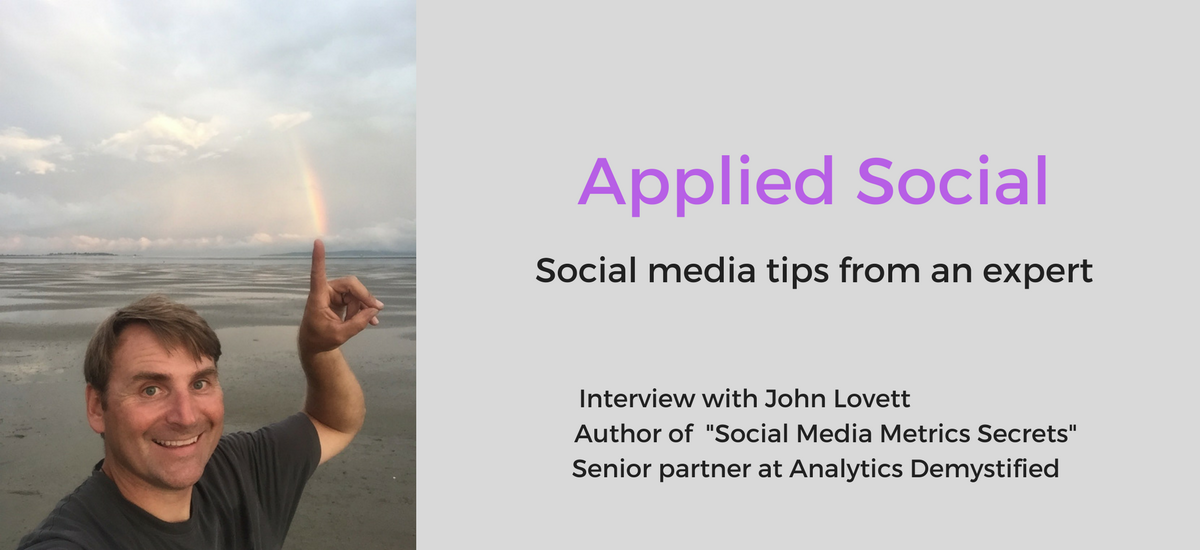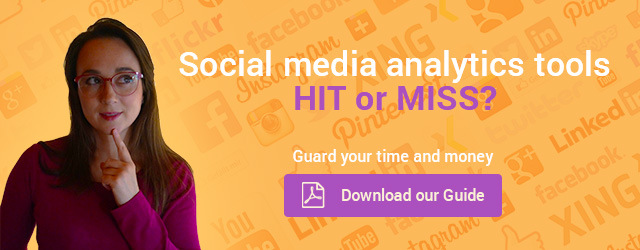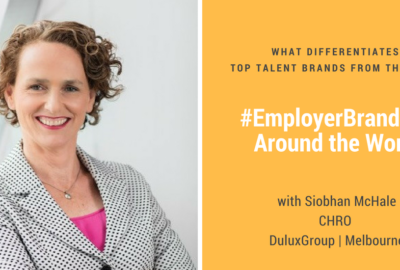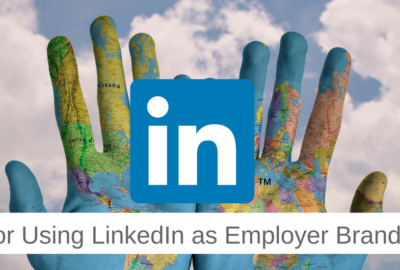Coaching, Consulting, Digital Marketing, Digital Trends, Leadership
Social media marketing tips from the experts
About John:
John Lovett is a Senior Partner at Analytics Demystified, a Mentor & Co-Founder @Analysis Exchange and an author of the book “Social Media Metrics Secrets: Do What You Never Thought Possible with Social Media Metrics”. He spent the past decade helping businesses analyze and measure their digital marketing activities, but more importantly, his passion for analytics pioneered the development of the social media measurement. Today John will be discussing virality and analytics behind social media – fasten your seatbelts.
John: Hi Dagmara, thanks for inviting me to participate in your applied social series. I’m honored to be among such esteemed company!
John, I am so thankful for your book about social media metrics and that you promote more strategic approach among social media professionals. At the end of the day, our supervisors ask us about the hard numbers. How can we achieve a consistent analytical approach in the “era of too many social media channels, metrics, and data overload”?
This is a great kick-off question because it happens at almost every organization starting out with social media measurement. What are the numbers? As an analyst or anyone practicing social media, your first inclination might be to spout off total followers, number of outbound posts, number of reactions, and more as fast as possible to provide a direct answer to the question asked. Yet, counting metrics like these rarely satisfy business questions. You must get to the Business Value Metrics and Outcome Metrics which is accomplished through strategic planning. This challenging task is achieved by developing a framework for social media that transcends channels and tactics and maps back to corporate goals. With a strategic framework in place, you can build campaigns and plan tactics designed to achieve your stated goals. Then, when your supervisor asks about the numbers, you can consistently report on progress against stated goals, which specific activities either contributed or failed, and what’s coming next to accomplish your goals. By architecting a strategy you can communicate metrics that matter, while also setting goals, managing expectations and reporting across all your social platforms.
Defining Business Value Metrics is extremely important while coming up with the social media strategy. Could you give us an example of aligning social activity to business goals?
When it comes to aligning your social strategy to activities, I always encourage clients to start with the corporate goal in mind. An example might be a CPG company looking to build awareness of its new consumer product. The corporate goals are expansion and adoption of this new product line. Thus, your social media activity might include creative design to drive new prospects to your social platforms to generate awareness, with a primary goal of finding advocates to promote the new product line. Let’s say in this hypothetical example, that you’re offering a coupon download to try a sample of the product. Business value metrics that you could use to showcase progress against the goals of awareness and adoption include cost per new fan acquired, total cost of campaign, number of coupons downloaded, coupon redemption rate, number of advocate Tweets per coupon, etc. The possibilities are endless if you take a strategic approach and align your tactics with overarching corporate goals. But more importantly, the impact of this approach when communicating Outcome and Business Value metrics to colleagues almost certainly has a greater appeal to your internal business audience.
Coming back to creativity. Using data and identifying new opportunities require creativity. Could you give us an example of a product or a service that used creativity to bring data to the next level and unlocked its potential?
I’m continually amazed at creativity in social media. Whether it’s reactionary like Wendy’s response to the tweet, “Yo @Wendy’s how many retweets for a year of free chicken nuggets?”. Or strategically planned like Lego’s LEGO Life app. Companies are continually pushing the limits of creativity in social media by allowing consumers to push their own limits and take ownership of their own ideas. When a kid can create their own LEGO mini figure and chat to their peers in a safe and safeguarded emoji language…now that’s creative!
Can you share the best way of retaining follower base and the way of measuring the retention rate?
When it comes to retaining followers, the best way that I’ve seen is to consistently generate content. And I’m not talking about pre-canned Tweets or recurring Facebook posts touting products here. What keeps people coming back is interesting, thought provoking content that is altruistic in nature. Consumers are smart these days and if you’re disingenuous in your social marketing efforts, they’ll tear you to shreds and then they’ll leave you. On the flip-side being real and authentic while also creating interesting content will keep your audience coming back. Retention can be measured in a number of different ways, but for social platforms, I like to look at the number of followers at the end of each month; subtract the number of new followers; then divide by the number of followers at the beginning of the month. [(followers month end – new followers)/followers month start*100]. This will give you a monthly retention rate. For apps, I tend to look at Monthly Active Users. Calculating this is a bit more complex, but essentially you’re tracking events per user and attributing active status to any user that participates in a certain number of events that meet your threshold. Using this method, you can quantify how many people within your install base actually uses your app in a given month.
Let’s dive into the topic that everyone secretly dreams about, but does not want to admit it. Virality. What an elusive goal! John, any idea what could be the key variables that drive viral growth? Or should we just…spray and pray?
Please don’t spray and pray! The best social strategies are well considered and well-planned ones. While you cannot plan for virality, you can schedule your social content to align with your editorial schedule, your planned corporate promotions, your scheduled content and most importantly your strategy. Organizations that create social calendars and allow room for spontaneous and responsive content are most likely the winners in social media. In my opinion, virality in social media is capturing the hearts and minds of the critical mass. Unfortunately, you can’t plan for this. More often than not content goes viral when it evokes strong emotions. But putting this type of content out there is easily foiled and it makes companies vulnerable. Those that take the risk are often just putting themselves out there, but one in a million hit the jackpot and go viral. I wish I could give your readers the secret to viral content, but alas, I do not have the magic bullet.
What is the biggest challenge while using social media for advertising and the way to overcome it?
Well, when it comes to advertising there are two giants in the mix Google and Facebook. These platforms consume nearly 99% of all new ad spending. According to the IAB, Google consumes 54% of all new ad spending and Facebook claims 45% of new ad spending growth. This research illustrates that the real platform that your question addresses is Facebook. The remaining 1% of ad dollars are split among everyone else. So, what are the challenges of advertising on Facebook you ask…? Well, targeting your audiences is critically important and Facebook actually does a pretty good job of allowing businesses to do this via custom audiences and lookalike audiences. Through the Ads Manager and Power Editor, social media managers can get a handle on who they want to target and how to get them that fresh advertising content.
How would you define the success of a non-quantitative social media activity? Should we even spend time on data we cannot quantify?
Non-quantifiable activity is anything that isn’t directly contributing to your bottom line. And sure, this is definitely worth measuring. Lots of activity on social is about building your brand, or creating credibility, or simply being there for your audience. If everything businesses did on social was revenue driven, the social web would be a pretty thin and boring space. Going back to my earlier answers, creativity and authenticity make social interesting. Brands that measure engagement and key into content that gets users coming back is what’s really compelling. Take a brand like Yeti. They predominantly make coolers and hats. Before we had the web and social, this is downright boring! But they’ve built and incredible brand. They generate so much brand goodness through campaigns like Yeti Presents on YouTube and just showing the wildly interesting people that they sponsor (without product overtures by the way) that makes me want to buy their products. I’m not sure that you can measure that. But I call it value.
What is the one social media metric you would die to measure, but no one out there came up with a solution yet?
I’m bullish on Engagement. Everyone needs this metric. Everyone talks about this metric. But no one knows exactly how to measure it. The challenge with Engagement is that people can engage with social (or websites, or Apps, or TV’s or game consoles) in so many different ways that it’s tough to come up with a universal definition for engagement. As such, marketers have a very difficult time defining and explaining engagement and business people have an even harder time wrapping their heads around it. I’ve come up with my own calculations on a case by case basis, but that’s what they’re destined to be until somebody who’s voice is louder than mine can shout over the din of singular consciousness to form consensus around engagement.

Engagement or reach?
Quality or quantity? That’s how I look at those metrics. Reach is about getting them to notice you, which is definitely important, but Engagement is about keeping their attention. That’s where you win.
In the last 5 years we noticed an exponential increase in social media measurement platforms, there is also more awareness on how to use Google Analytics for examining audience, driving brand awareness or sales in social. Is there still a need to create and calculate your own customized metrics for social media? Can you give an example of when it would be necessary?
There are so many great tools out there for social managers, marketers, and analysts to use that it’s dizzying. Most tools do a good job of capturing the base metrics, or “counting metrics” as I call them in my book. But there will always be a need to generate calculated metrics to derive rates and ratios and to mix dimensions for deep analysis. For example, you probably already know how much social content you generate on all your various social platforms. But do you know what your share of voice among competitors is? To quantify this, you’ll need to do some customization to determine your competitor’s activity and to compare that to your own. Another example might be tracking “amplification rate”, which would give you not just the number of shares, but Shares divided by Followers (or likes, or pins) and multiply by 100 to get a rate. I do believe that as long as there are creative analysts looking for interesting ways to tell a story with their data that there will be a need for custom metrics.
What is the newest social media trend you would love to explore more?
One trend in social media that literally keeps popping up is Chatbots. Whether on Facebook or Slack, these seemingly helpful bots are working their way into social sites everywhere. I’m personally not a fan, but then again, I didn’t like Microsoft Clippy either. What I’d most like to explore is the AI side of social. The sheer volume of data emanating from social sites will be impossible for all the data scientists in the world to parse through without assistance. This assistance will come from artificial intelligence. The ability to surface unstructured data, whether it’s facial recognition, image interpretation, or comments in posts…the potential is huge. Who knows, maybe AI can help us weed out the fake news too?
What is the biggest challenge on social media now, in comparison to what it was 5 years ago?
I really think the biggest challenge in social media today is the same as it was 5 years ago…and it’s authenticity. The ability to be authentic and remember that the whole reason we’re doing this is to interact with other people is the main idea. But it’s so easy to lose sight of that. Especially when working for a large enterprise or for a big brand with deadlines and expectations for performance. Yet, social media must be genuine and that requires actually listening to people and responding to people in a thoughtful way. It also requires creating original content and images and thoughts…which is really hard to do! Authenticity in social media is hard and that won’t go away with all the Chatbots or AI support.
They say that failures make us stronger. Would you be so kind and give us an example of one of your failures and what did you learn from it?
Ugh! Failing is easy to do. Probably one of my biggest failures was creating a Framework for social media that was just too complicated. I spent countless hours building a model and explaining it to stakeholders from the most junior social media intern all the way up to the Chief Marketing Officer. The more I had to explain the more I felt like I was losing the battle. This taught me a valuable lesson, which is one of the oldest ones in the book; Keep It Simple Stupid! I learned that complex social strategies are necessary, but revealing all the dirty details isn’t. I had to learn how to read my audience and cater to their level of understanding so that it was broken down into simplest terms. My strategies still have lots of complexity baked into the calculations and tactical details, but they can be explained in two sentences or less and the top line results are clearly aligned with goals that everyone knows and understands. Social media is a very complicated space, but keeping it simple by relating back to the people that you interact with and communicating to stakeholders how that impacts your corporate goals is the best lesson that I’ve learned in my work.
Thank you for the interview!
Comments are closed













